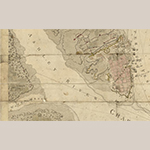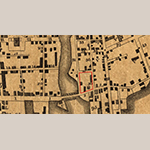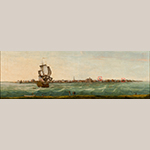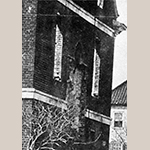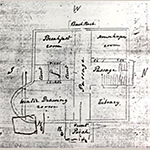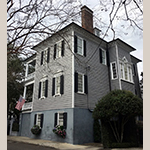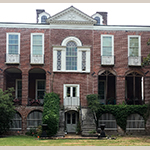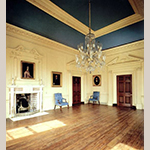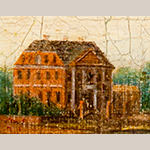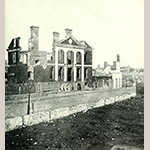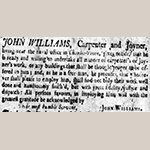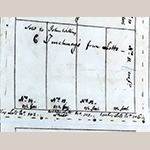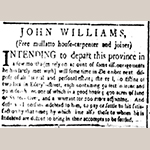Previous accounts of John “Quash” Williams’s life have centered his story around his relationship with the Pinckney Family of Charleston, South Carolina. Williams is often noted as the enslaved man who assisted Eliza Lucas Pinckney in the production of a successful indigo crop. Additionally, he is also known as the enslaved carpenter responsible for the carpentry and joinery work on the circa 1750 Pinckney Mansion in Charleston, one of the city’s grandest pre-Revolutionary houses. Williams’s relationship with the Pinckneys, first as an enslaved man and later as a free man of color, is the most well-documented portion of his life. New previously unpublished research has uncovered the story of Williams both before and after his work on the Pinckney Mansion adding a significant layer of insight into his life while also providing an uncommonly rare view into the complexities of enslavement, craftsmanship, and freedom in the colonial South. These new findings emphasize the fact that it is past time for Williams’s accomplishments to receive the recognition they deserve.
This article examines the life of John “Quash” Williams through his best known masterpiece, the circa 1750 Pinckney Mansion, and illustrates how the mansion itself was a catalyst in Williams’s story. This dwelling, destroyed in the devastating 1861 Charleston fire, frames the progress of a remarkable man who, while actively performing within the racial boundaries of an enslaved man, worked towards the liberation of himself, his family, and the other skilled enslaved craftsmen whom he had trained, supervised, and paid wages. In order to free himself and those enslaved like him, Williams had to appeal to the sensibilities of both the Lucas and Pinckney families in Charleston. What becomes overwhelmingly clear is that in their pursuit of material success, both sides—the enslaved and their enslavers—used and exploited the fluid nature of race in the eighteenth-century Lowcountry.
Williams’s Early Life
Details surrounding John “Quash” Williams’s early life are scant at best. What is known, based on Williams’s written descriptions of himself, is that he was most likely born between 1720 and 1725 in South Carolina to an African mother and a white father.[1] Quash was Williams’s given birth name. On the occasion of his baptism in 1746 he took on the name John Williams for himself.[2] Quash, which means “Sunday” in several related West-African languages, was a popular name given to enslaved boys born on Sundays, a practice based on the traditional African practice of naming infants based on the day of the week on which they were born.[3] Williams’s parents are unknown. Williams’s mother was most likely enslaved at Wappoo Plantation, a 600-acre plantation located on Wappoo Creek, a branch of the Ashley River, three miles southwest of Charleston (Figure 1). In 1714, John Lucas of Antigua, a planter and member of the Assembly of Antigua, purchased Wappoo Plantation. Previous research indicates that Lucas was solely interested in the plantation as an investment to sustain his wealth. There is no evidence that he spent any time there.[4] When Lucas died in 1729, he left the plantation to his son, George Lucas, father of Eliza Lucas.
Whether through visits to South Carolina or correspondence, George Lucas familiarized himself with Wappoo Plantation. In 1738, Lucas mortgaged the property to Charles Dunbar. The mortgage document provides one of the first descriptions of Wappoo Plantation: It encompassed 600 acres, included a dwelling house and outbuildings, and was home to “12 able negro men and eight able negro women.” [5] John “Quash” Williams was one of these enslaved men.
One of the earliest record documenting of Williams’s existence is a 7 January 1743 recollection of a letter from Eliza Lucas to her father, George Lucas. When Eliza wrote the letter, she was in charge of her father’s South Carolina plantations while her father continued his work as a British Army Officer in Antigua. Eliza referred to Williams by his birth name of Quash:
wrote to my father concerning my brother Tommy, his Nurse, his pretty stile in writing &c. Inform him of some Negroes detected going to Augustine they accused Molo Quash I was at his tryal when he proved him self quite Innocent. The ring leader is to be hangd and one Whyp’d.” [6]
Just three years before Williams’s trial, the Stono Rebellion shocked South Carolinians, and much like in Williams’s case, those enslaved men and women who participated in the Stono Rebellion were said to be headed to St. Augustine in Spanish Florida. According to the South Carolina Negro Act of 1740, the punishment Williams faced at this trial for attempting to run away was death by hanging.[7] Unfortunately, due to the unregulated nature of these slave court trials, no records of Williams’s experience still exist. What we do know about his prosecution is based on Eliza’s eyewitness account from the courtroom.
The convening of slave courts drew locals from all around to witness the trials and subsequent punishments. Often their attendance was powerful enough to influence the decisions of the justices. One can assume that many people attended the trial of the three enslaved men charged with inciting a slave rebellion so soon after the Stono Rebellion. Eliza was undeniably in a unique position as the female head of three plantations at the young age of twenty. Her presence and visible support of Williams at trial surely aided in his defense of himself. Existing records of slave court trials reveal that the enslaved could defend themselves, and that at the start of these trials they could answer if they were innocent or guilty. It would have been Williams’s responsibility to speak for himself in a manner that persuaded the justices to believe that he was innocent. We know that he was successful in doing so.
Williams’s successful defense of himself is reflective of his character. Furthermore, Eliza’s attendance at the trial proves that he was important to her and her family and that the accusations against him were out of character. Adding to the macabre scene of slave court trials was the fact that the justices received compensation for the executions of the enslaved. Money was set aside in the colony’s annual budget to pay for these executions.[8] Additionally, the colony provided enslavers with £200 if the enslaved individual they owned was executed.[9] Williams could have easily died at the hands of a dishonest justice, but Eliza’s presence undoubtably provided visible support to his more than effective defense of himself.
What emerges from an analysis of the relationship between Eliza Lucas and John “Quash” Williams is that she greatly depended on him. Documents reveal that Williams aided Eliza as a driver at Wappoo. Additionally, he assisted her with her indigo experiments when he created two wooden indigo vats at the request of George Lucas. On 24 December 1744, George Lucas wrote to Charles Pinckney stating:
I have Since Recollected upon my Wife’s telling me the Indigo Nics. Cromwell made gave linnen a red Cast, that it may possibly continue some time if not always as the worke is made of Bricks, I therefore Desire Quashe may be put immediately to make an Indigo Work, of the same Dimentions with the Brick one at Wappo, on Garden Hill plantation with Plank, & timber, the Plank to be well Joynted, & Pin’d, with wood to the Frame on the Inside.[10]
Williams’s creation of wooden indigo vats in 1744 and 1745 contributed to a successful and abundant indigo crop for the Lucas family. The overseer at Garden Hill Plantation, William Murray, indicated in his accounts for 1745 that he shipped indigo worth more than 225 British pounds to London. Furthermore, Eliza told her father that Williams had spent thirty-three days away from Wappoo Plantation building wooden indigo vats at other Lucas family plantations.[11]
On 25 May 1744, Charles Pinckney married Eliza Lucas. For Williams, this marriage meant that Charles Pinckney now claimed ownership of his body and labor as Pinckney received twenty enslaved men and women as well as the Lucas family’s Wappoo Plantation as part of the marriage settlement.[12] At that time, Williams could not have imagined the opportunity brought to him by Charles Pinckney nearly three years later. His woodworking skills as well as the high regard held for him by the Lucas family prompted Pinckney to approach Williams in late 1746 with architectural drawings and a contract for his labor.[13]
Williams and the Pinckney Mansion
In 1745 Charles Pinckney began contemplating what would become his architectural statement house at the corner of East Bay and Guignard streets in Charleston (Figure 2). At the time, East Bay Street was home to various businesses and warehouses supporting Charleston’s busy harbor. Pinckney chose to construct his house on the north end of East Bay Street across Governor’s Bridge at Colleton Square. Pinckney’s desired location for his mansion, accompanied by his purchase of the low-water lots in front of his house, guaranteed that it would be as much of a focal point for incoming ships as the steeple on St. Philip’s Church (Figure 3).
Within Charles Pinckney’s papers, held at the South Caroliniana Library at the University of South Carolina, are detailed construction plans in Pinckney’s hand detailing the work he sought for the mansion. Pinckney was a gentleman architect in every sense and his travels throughout Europe greatly influenced the architectural styles that he wanted for his Charleston home. Pinckney’s architectural plans reflect not only his aspirations but also his expectations of his carpenter and joiner John Williams.
The 4 November 1746 document titled “An Account of Carpenters and Joiners Work Proposed to be done in a Brick House for Charles Pinckney Esq at the North End of the Bay of Charles Town” includes four pages of Pinckney’s designs for the woodwork for each floor of the house and specific rooms as well as references to examples of woodwork in other Charleston area homes to follow as models. However, only one small architectural drawing of the mansion is known to exist.[14] From these manuscripts we know that Pinckney wanted a paved entry hall like that of Benjamin Whitaker, woodwork copied from Thomas Shubrick’s home, and a dining room elaborately finished like the one at Mr. Greeme’s home.[15]
On the cellar floor, Pinckney requested “2 outside cellar door frames 4-1/2 feet wide, 6 feet 2 inches high with a beed and single architrave, 4 inner cellar cases with a beed—no architrave.”[16] Pinckney’s request for a beed and single architrave most likely refers to what is now known as a bead and reel molding for the architraves, or the main beam across the top of the door frame. Pinckney was meticulous in his directions and deliberately requested that the four interior cellar door frames have no architraves. By intentionally leaving the interior woodwork for the cellar very plain in detail, perhaps Pinckney was emphasizing the cellar’s function as a workspace.
On the first floor, Pinckney requested details such as “one large Venetian window upon the half pace of the stairs according to the plan…best parlour to be wainscotted on the Chimney side, with double cornice round, surbase, window seats and jambs… .” (Figure 4).[17] From this description as well as the plan we know that the stairwell on the north side of the house was the location of the Venetian window and that the window projected out of the north elevation slightly (Figure 5). Architectural historian Gene Waddell, in his book Charleston Architecture 1670–1860, commented that the protruding stairwell featuring a Venetian window is also a detail seen on the later circa 1753 Humphrey Sommers house in Charleston (Figure 6). Sommers was one of the contractors involved in the construction of the Pinckney Mansion.[18] Additionally, the circa 1769 Miles Brewton House also featured a protruding stairwell. Subsequent renovations to the Miles Brewton House included additions around the stairwell that eventually made the rear elevation of the house flush (Figure 7). Photographs of the Pinckney Mansion taken in 1861 reveal that its stairwell was made flush by the time of the 1850 floorplan pictured in Figure 5 and the 1861 photographs pictured in Fig. 4.
Pinckney noted that each room on the principal floor was to have surbase and skirting boards, paneled doors, wainscotting, window seats, and cornices.[19] On the second floor, Pinckney requested details such as:
The dining room ceiling to be coved into the roof, so as to make this room at least 14 foot high in the clear. This room is intended to be wainscotted and finished as Mr. Greemes is, if the charge be not too great, and therefore I desire the charge of it may be considered by itself and made a distinct article of.[20]
Waddell argued in his book that the circa 1769 Miles Brewton House dining room is nearly identical in form and dimensions to the Pinckney dining room constructed twenty years earlier (Figure 8).[21]
In 1896, Mrs. St. Julian Ravenel, a Pinckney descendant, published a description of the mansion in her book on Eliza Lucas Pinckney. She wrote:
The lot occupied the whole square from Market to Guignard Streets, on the western side of the East Bay. The house stood in the centre, facing east to the water, and the ground across the street, down to the water’s edge, also belonging to the family, was never built upon, but kept open for air and for the view. It was of small, dark English brick, with stone coppings, and stood on a basement containing kitchens and offices. It had, besides the basement, two stories, with high slated roof, in which were wine and lumber rooms. From the front to the back door was a wide flagged hall, into which four large rooms opened; dining-room and bed-room to the south, library and house-keeper’s room to the north. These two last were not as large as the southern rooms, for the staircase, partly accommodated by a projection on the north side of the house, came down into a kind of side hall between them. The window on this staircase (one of the most remarkable features of the house) was very beautiful, of three arches with heavily carved frames, and a deep window-seat extending the whole length of the landing-place. On the second story were five rooms; the large and small drawing-rooms occupying the whole east front of the house, the large one a very handsome room, over thirty feet long, with high coved ceiling and heavy cornice, beautifully proportioned. At the back were bedrooms, and the staircase went on to the garrets above.
The whole house was wainscotted in the heaviest panelling, the windows and doors with deep projecting pediments and mouldings in the style of Chamberlayne. The mantelpieces were very high and narrow, with fronts carved in processions of shepherds and shepherdesses, cupids, etc., and had square frames in the panelling above, to the be filled with pictures.
The house differed from those of later date in Carolina, by having the kitchen and offices in the basement, — an almost unknown thing there in after years, — and in the absence of extensive piazzas. In front there was only a high flight of stone steps with a small canopied porch, at the back a small piazza on the first floor only. A little way off, along the northern edge of the lot, was a long row of buildings, servants’ rooms in great number, stables, coach-houses, etc. A vegetable garden was at the back, and grass plats with flower beds filled the southern part of the lot, one of the largest in the town.[22]
What Charles Pinckney’s 1746 “Carpenters and Joiners Work Proposed” document and Mrs. St. Julien Ravenel’s description suggest is that John Williams was indeed a master carpenter. His time spent laboring on the Lucas and Pinckney family plantations constructing indigo vats, coops for deer, and completing other tasks clearly prepared him for the task at hand. Not only did Williams complete a great deal of the Pinckney Mansion woodwork himself, but he also supervised the work of other enslaved craftsmen as well as that completed by white craftsmen and laborers. Documents within the Pinckney Papers indicate that Williams managed a workforce of at least eight men. Among them were the enslaved men Charles, Pompey, Patrick (Williams’s designated apprentice), Caesar, Peter, Prince, and Archer, as well as a white man by the name of Charles Richmond Gascoynes who promised to pay off his debt owed to Pinckney through working under Williams’s supervision.[23] Together, Williams and his crew completed the woodwork for the Pinckney Mansion including making window frames and sashes, door frames and paneled doors, girders and floor joists, as well as carving mantlepieces, wainscoting, double cornices, and surbase and skirting boards.
In 1750, at the time of its completion, the Pinckney Mansion was one of the first Palladian villas to be built in Charleston (Figures 9 and 10) and likely the earliest house in the United States to have a temple front superimposed on its façade.[24] The façade of the house consisted of five bays. The three center bays comprised the architectural focus of the temple front. Marble pilasters separated each of the three center bays and supported a classical entablature and pediment. The two remaining bays formed one-bay wings. Gene Waddell suggested that Pinckney not only introduced the pattern of the temple front into Charleston’s architectural vocabulary, but that he was also the first American to emphasize the classical architectural orders against a background of brick.[25]
The Pinckney Mansion was indeed in a league of its own. Previous scholarly works describing the mansion’s architectural significance have often compared it to Drayton Hall, suggesting that Pinckney drew inspiration from John Drayton’s Palladian home on the Ashley River. Recent dendrochronology tests, however, have revealed that the timbers for the roof of Drayton Hall were cut in the winter of 1747/1748, giving Drayton Hall a construction timeline of 1748 to 1752.[26] By October of 1747, bricklayer Joseph Black had completed the masonry work on the Pinckney Mansion, and by the end of that month roof slater Humphrey Sommers submitted bills for payment for the roof work he was in the process of completing.[27] Together, the dates provided by dendrochronology and the evidence found in the Pinckney Papers reveal that the Pinckney Mansion pre-dated Drayton Hall.
For John “Quash” Williams, this recent merging of evidence indicates that Pinckney’s architectural designs and Williams’s execution of these designs may have influenced the architect responsible for Drayton Hall. They most certainly influenced the circa 1769 Miles Brewton House with its protruding stairwell with Venetian (Palladian) window and a dining room nearly identical to the one in the Pinckney Mansion. Additionally, the front steps of the Miles Brewton House were similar to those of the Pinckney Mansion. Through this lens, the Pinckney Mansion emerges as an iconic building that set the style for an entire generation of iconic buildings. It is vital to note that the work behind these iconic buildings was accomplished at the hands of enslaved individuals like John Williams.
With the Pinckney Mansion completed in April 1750, Williams’s best known work was on display for all Charleston to see. As he undeniably basked in the joy of a completed project, he soon had a much better reason to celebrate: On 12 May 1750, Charles and Eliza Lucas Pinckney freed Williams from the bonds of enslavement.[28] Just three weeks later, Williams placed an advertisement in the South Carolina Gazette for his services as a carpenter and joiner, noting that he was a free man of color (Figure 11).
Williams’s Life After the Pinckney Mansion
For too long, the entirety of John Williams’s life has existed in the shadows cast by the Pinckney Mansion and his relationships with the Pinckney and Lucas families. Williams’s unique personal and professional experiences after his emancipation reveal an individual who keenly understood how to succeed in a society that did not view him as an equal. It is past time for his accomplishments to receive the recognition they deserve.
On 16 April 1746, Alexander Garden baptized Williams. The entry in the register of St. Philips’s Church stated, “John William, a Negroe, was Baptized. Pr Revd Mr. Garden.”[29] Corroboration that this individual is indeed the builder John “Quash” Williams is found in a 1746 bill of sale between Charles Alexander and Charles Pinckney that describes Williams as “Quash a Carpenter (since Baptised by the name of John Williams).”[30] Williams continued to have a relationship with Alexander Garden, Reverend of St. Philip’s Church, well past the date of his baptism. It is also possible that Williams was a student at Garden’s “Negro School,” which opened 12 September 1743.[31] Pinckney was a supporter of Garden’s school and may have suggested that Williams enroll.[32] Regardless of how they became acquainted, Garden remained a compelling figure in Williams’s life until Garden’s 1756 death.
The same year as his baptism, 1746, Williams was spending the majority of his time in Charleston at the Pinckney’s townhome. A 5 August 1746 inventory lists Williams under the heading of “Negroes in Charles Town.”[33] Williams’s relocation to Charleston from Wappoo Plantation is significant because it is during this period that he most likely became acquainted with his future wife Molly. An enslaved woman, Molly was owned by Charleston merchant Joseph Pickering.[34] Pickering worked on Motte’s Wharf and lived on Bedon’s Alley near the south end of East Bay Street.[35] Charles Pinckney owned property at the south end of East Bay Street and often sent his enslaved craftsmen to his various Charleston properties to complete work. It is plausible that Williams could have met his wife when he was assigned to one of those jobs. Additionally, Williams may have met his wife through St. Phillip’s Church or Alexander Garden’s School as both Pinckney and Pickering were members of St. Phillips and well acquainted with Garden.
In July 1750, two months after Charles and Eliza Lucas Pinckney emancipated him, Williams became a Charleston property owner when he took possession of 13 and 14 Ellery Street (Figure 12). A land deed dated July 1750 recording the sale stated:
Charles Pinckney Esq. & Elizabeth his wife, to the Rev. Alexander Garden, rector of the parish, in trust for John Williams, joiner and carpenter, of Charleston for £900 currency, paid by Garden on account of Williams; 2 subdivisions of 4 town lots #13 and #14, to be held by Williams for 3 years and then to be sold by Garden at public auction if he wished…now Garden has advanced the £900 for which Williams has conveyed the 2 lots to Garden in trust for his [Williams’s] children; Amy, Mary, and Sabina; Garden agreeing to convey to Williams upon payment of bond.[36]
Historian Gene Waddell suggested that Pinckney paid Williams in part for his work completed on the mansion by giving him the land.[37] Regardless, with Williams’s possession of lots on Ellery Street he not only became a landowner but also Pinckney’s neighbor. The land given to Williams by Pinckney and held in trust by Garden was next door to the Pinckney Mansion and across the street from the future Charleston City Market at the present-day corner of East Bay and North Market Streets.
Williams’s carpentry skills, combined with his leadership as master carpenter on the Pinckney Mansion, contributed to not only his emancipation, but also the emancipation of his children. The land deed identified Williams’s children with his wife Molly: Amy, Mary, and Sabina. Unmentioned in the land deed is their son Peter. By 14 October 1751, eighteen months after his emancipation, Williams purchased daughters Sabrina and Molly and son Peter from Joseph Pickering for 200 British pounds.[38] He was unable to purchase his wife Molly and his youngest daughter Amy because Pickering would not agree to their sale. Williams subsequently emancipated his children in 1754.[39] Pickering’s 1757 will and probate records indicate that he willed Molly and Amy to his wife, Ann Brasseur, upon his death.[40]
Williams continued to work for Charles Pinckney even after the completion of the mansion. In a June 1750 to April 1752 document titled “The Hon. Charles Pinckney Esq. to Jne Williams,” Williams recorded the tasks completed by himself and men enslaved by Pinckney including Williams’s former apprentice, Pompey. For example, Williams wrote: “October 2, 1751 – To 1/4 day self, Archer and Patrick at Capt. Shubrick… 0”15”0.”[41] Williams also noted other tasks completed by himself and men enslaved by Pinckney, including altering dormer windows, putting on latches and locks, mending a table, putting up bedsteads, and carting cypress boards.[42] Importantly, this document and others indicate that John Williams was not the only enslaved man to benefit from Williams’s building talents. By teaching other enslaved men the carpentry and joinery trades and supervising their work, Williams equipped those men with skills that elevated them beyond laborers to the status of craftsmen. Because of Williams, these enslaved men were able to earn wages (above and beyond the hiring-out rates paid to their enslavers), find their own lodgings in Charleston, contract work for themselves, and gain a small degree of independence.[43]
In 1763, with his children in tow, John Williams announced plans to leave the city to make a life for himself as a carpenter and house joiner.[44] Williams had what was, perhaps, the finest home in Charleston as his advertisement and over a decade of experience working on his own. Additionally, he had the appreciation of both Charles and Eliza Lucas Pinckney due to his work for them throughout the years.
Before the Pinckneys left Charleston for Britain in 1753, the couple also provided Williams with an essential tool for furthering his studies in the building trades. In his account book, Charles Pinckney recorded that Williams paid him £4 for “a Book of Architecture.”[45] The price of the book was not insignificant for the time and suggests an essential text. In 1728, British architect James Gibbs published his book titled A Book of Architecture, containing designs of buildings and ornaments. Gibbs’s architectural influence was apparent throughout Pinckney’s designs for the Pinckney Mansion, most visibly in his request for a coved ceiling in his dining room. Coved ceilings featured heavily throughout Gibbs’s book. Thus, the book Williams likely purchased from Pinckney was Gibbs’s A Book of Architecture.[46] What remains to be discovered is if any other extant buildings possibly associated with Williams exist and whether or not they featured designs from Gibbs’s book.
Conclusion
Most published accounts of Williams’s life end with his 1763 announcement in the South Carolina Gazette of his intended departure from Charleston (Figure 13). But his story does not end there. Much of Williams’s life after his 1763 newspaper notice remains to be thoroughly researched.
What we do know about Williams’s life and his story is that he left behind an important legacy of skilled Black craftsmanship. His influence was felt throughout the Lowcountry as the Pinckney Mansion became a home imitated by others. He not only was responsible for hand carving and hand constructing the woodwork of the Pinckney Mansion, but he also was responsible for managing a workforce of laborers both enslaved and free, Black and white. In that role, Williams wrote detailed accounts of their comings and goings, the work that they completed, and the wages they received. Williams’s accounts reveal a well-educated craftsman who thoroughly understood the labor needed to complete substantial and ornate architectural projects.[47]
Not only was Williams keenly aware of his skills and the Charleston labor market, but what emerges is the story of an African American man who understood what was required to uplift himself and his family in a society that neither saw him nor treated him as an equal. When Williams received the deed for his lots on Ellery Street in 1758—free of mortgage—he was described as “John Williams of St. James Parish Santee Carpenter and Planter.”[48] His rise in status from enslaved man to free man of color to that of planter represents a virtually unique trajectory nearly inaccessible to enslaved individuals, as well as most white people, in colonial America.
What Williams represents is that the stories of enslaved and free African American craftspeople are more than just the stories of the objects they created. These stories are distinctly American stories, yet they are often neglected in America’s historic sites and museums. More than anything, these stories represent the triumph of African American lives and the physical legacy of objects created and left behind, remembered, and treasured in a society designed to prevent such legacies from ever existing.
Moving forward, my research will explore Williams’s post-1763 life, follow the journey of Williams’s wife Molly and daughter Amy under the ownership of Ann Brasseur, examine Williams’s life as a planter on the Santee River, and delve deeper into issues of race, class, resistance, and craftsmanship at the dawn of the American Revolution. What is apparent at this stage of research is that while the Pinckney Mansion is the best-known example of his work, Williams’s story and his legacy is about more than just the architecture of one building. Not only did John “Quash” Williams craft one of Charleston’s greatest mansions, he also crafted his own version of freedom.
Dr. Tiffany Momon is a Visiting Assistant Professor of History at Sewanee, The University of the South. She is also a founder of the Black Craftspeople Digital Archive. Dr. Momon can be contacted at [email protected].
[1] John Williams, “John Williams,” South Carolina Gazette (Charleston, SC), 13 August 1763.
[2] A. S. Salley, ed., Register of St. Philip’s Parish, Charles Town, South Carolina, 1720–1758 (Columbia: University of South Carolina, 1971), 137; available online: https://hdl.handle.net/2027/wu.89067450395 (accessed 17 September 2020).
[3] Peter H. Wood, Black Majority: Negroes in Colonial South Carolina: From 1670 through the Stono Rebellion, reissued (New York: Norton, 1996), 181–182; John C. Inscoe, “Carolina Slave Names: An Index to Acculturation,” The Journal of Southern History, Vol. 49, No. 4 (1983): 532–33; David DeCamp, “African Day-Names in Jamaica,” Language, Vol. 43, No. 1 (1967): 139–140. DeCamp suggests that it is nearly impossible to determine which African dialect was spoken by the enslaved individuals who brought day-names, such as Quash, to the Americas, but that the closest modern dialect is Twi, spoken by Ghanians.
[4] Beatrice St. J. Ravenel, “Notes on John and George Lucas,” The South Carolina Historical and Genealogical Magazine, Vol. 46, No. 4 (1945): 185.
[5] George Lucas, “George Lucas To Charles Dunbar, Mortgage For 600 Acres Of Land On Wappoo Creek, 20 Negroes And All His Livestock,” 5 July 1738, Conveyance Books (Public Register), S372001, South Carolina Department of Archives and History, Columbia, SC.
[6] Eliza Lucas Pinckney, “Eliza Lucas Pinckney to George Lucas, 7 January 1743,” The Papers of Eliza Lucas Pinckney and Harriott Pinckney Horry Digital Edition,” 7 January 1743, University of Virginia Press, Charlottesville, VA; online with subscription: http://rotunda.upress.virginia.edu.proxy01.its.virginia.edu/PinckneyHorry/elp-details.xqy?letter=/PinckneyHorry/ELP0808.xml&qs=Quash (accessed 17 September 2020).
[7] John Belton O’Neall, The Negro Law of South Carolina (Columbia, SC: J.G. Bowman, 1848), 30.
[8] Robert Olwell, Masters, Slaves & Subjects: The Culture of Power in the South Carolina Low Country, 1740–1790 (Ithaca, NY: Cornell University, 1998), 76, 78, 81.
[9] For more see Lorri Glover, Eliza Lucas Pinckney: An Independent Woman in the Age of Revolution (New Haven, CT: Yale University Press, 2020), 63 and “An act for the better ordering and governing Negroes and other slaves in this Province,” 10 May 1740, in The Statutes at Large of South Carolina, vol. 7, ed. Thomas Cooper and David J. McCord (Columbia: A. S. Johnston, 1840), 397–417.
[10] George Lucas, “George Lucas to Charles Pinckney, (1699–1758), 24 December 1744,” The Papers of Eliza Lucas Pinckney and Harriott Pinckney Horry Digital Edition, 24 December 1744, University of Virginia Press, Charlottesville, VA; online with subscription: http://rotunda.upress.virginia.edu.proxy01.its.virginia.edu/PinckneyHorry/elp-details.xqy?letter=/PinckneyHorry/ELP0223.xml&qs=%22garden%20hill%22 (accessed 17 September 2020).
[11] Andrea Feeser, Red, White, and Black Make Blue: Indigo in the Fabric of Colonial South Carolina Life (Athens: University of Georgia, 2013), 105.
[12] Eliza Lucas Pinckney, “Eliza Lucas Pinckney, Marriage Settlement, May 1744,” The Papers of Eliza Lucas Pinckney and Harriott Pinckney Horry Digital Edition, 1 May 1744, University of Virginia Press, Charlottesville, VA; online with subscription: http://rotunda.upress.virginia.edu.proxy01.its.virginia.edu/PinckneyHorry/elp-details.xqy?letter=/PinckneyHorry/ELP0211.xml&qs=settlement (accessed 17 September 2020).
[13] Charles Pinckney, “1746 Nov 4 An Account of Carpenters and Joiners Work Proposed to Be Done in a Brick House for Charles Pinckney Esq. at the North End of the Bay of Charles Town,” 4 November 1746, The Pinckney Papers, South Caroliniana Library, University of South Carolina, Columbia, SC.
[14] Waddell noted that only one small sketch of the architectural plans for the house is known to exist, but that in 1745, Pinckney mailed a set of architectural plans to Eliza’s brother George Lucas Jr. Lucas responded, “In my humble opinion tis plann’d out in a very pretty Genteel taste & all the apartments pettily laid out.” Gene Waddell, Charleston Architecture, 1670–1860 (Charleston, SC: Wyrick, 2003), 81, 97.
[15] Ibid, 81.
[16] Pinckney, “1746 Nov 4 An Account of Carpenters and Joiners Work Proposed to Be Done in a Brick House for Charles Pinckney Esq. at the North End of the Bay of Charles Town.”
[17] Ibid.
[18] Waddell, Charleston Architecture, 88. Waddell also wrote that many of the houses with stairwell projections likely followed Pinckney’s example.
[19] Pinckney, “1746 Nov 4 An Account of Carpenters and Joiners Work Proposed to Be Done in a Brick House for Charles Pinckney Esq. at the North End of the Bay of Charles Town.”
[20] Ibid.
[21] Waddell, Charleston Architecture, 85.
[22] Alice R. Huger Smith and D. E. Huger Smith, The Dwelling Houses of Charleston, South Carolina (Charleston, SC and London: History Press, 2007), 371–372.
[23] Charles Pinckney, “The Pinckney Papers,” n.d., The Pinckney Papers, South Caroliniana Library, University of South Carolina, Columbia, SC.
[24] Waddell, Charleston Architecture, 79.
[25] Ibid, 84.
[26] Robert Behre, “How Old Is Your House?,” The Post and Courier (Charleston, SC), 9 May 2014; “The Roof of Drayton Hall: A Brief History,” Drayton Hall Blog (blog), n.d., online: https://www.draytonhall.org/drayton-hall-roof-brief-history/ (accessed 17 September 2020).
[27] Pinckney, “The Pinckney Papers.”
[28] Charles Pinckney, “Manumission, John (Quash) Williams, 12 May 1750,” The Papers of Eliza Lucas Pinckney and Harriott Pinckney Horry Digital Edition, 12 May 1750, University of Virginia Press, Charlottesville, VA; online with subscription: http://rotunda.upress.virginia.edu.proxy01.its.virginia.edu/PinckneyHorry/ELP1235 (accessed 17 September 2020).
[29] Salley, Register of St. Philip’s Parish, Charles Town, South Carolina, 137.
[30] Charles Pinckney, “Bill of Sale, Charles Pinckney, (1699–1758), 5 January 1750,” The Papers of Eliza Lucas Pinckney and Harriott Pinckney Horry Digital Edition, 5 January 1750, University of Virginia Press, Charlottesville, VA; online with subscription: http://rotunda.upress.virginia.edu.proxy01.its.virginia.edu/PinckneyHorry/elp-details.xqy?letter=/PinckneyHorry/ELP1272.xml&qs=Quash (accessed 17 September 2020).
[31] Fred E. Witzig, Sanctifying Slavery & Politics in South Carolina: The Life of the Reverend Alexander Garden 1685–1756 (Columbia, South Carolina: University of South Carolina Press, 2018), 143.
[32] Ibid, 146 and Alexander Garden, “Negro School-House at Charles Town Accompt,” South Carolina Gazette (Charleston, SC), 2 April 1744.
[33] George Lucas, “List of Slaves, George Lucas, 5 August 1746,” The Papers of Eliza Lucas Pinckney and Harriott Pinckney Horry Digital Edition, 5 August 1746, University of Virginia Press, Charlottesville, VA; online with subscription: http://rotunda.upress.virginia.edu.proxy01.its.virginia.edu/PinckneyHorry/ELP1253 (accessed 17 September 2020).
[34] Joseph Pickering, “Joseph Pickering to John Williams. Receipt for Purchase of Three Slaves,” 14 October 1751, Charleston Archive, record 80a, 105, South Carolina Room, Charleston County Public Library, Charleston, SC.
[35] In an advertisement in the South Carolina Gazette on 8 May 1742, Pickering indicated that he worked at Motte’s Wharf. In an advertisement in the same newspaper on 2 September 1751, Moss Audibert indicated that he was looking to rent the house occupied by Pickering in Bedon’s Alley. Joseph Pickering, “Just Imported,” South Carolina Gazette (Charleston, SC), 8 May 1742 and Moses Audibert, “The House in Bedon’s Alley,” South Carolina Gazette (Charleston, SC), 2 September 1751.
[36] Charles Pinckney, “Pinckney, Charles And Wife To John Williams And Alexander Garden, Mortgage Of Lease And Release For 2 Town Lots In Charlestown,” 1750, Conveyance Books (Public Register), S372001, South Carolina Department of Archives and History, Columbia, SC.
[37] Waddell, Charleston Architecture, 93.
[38] Pickering, “Joseph Pickering to John Williams. Receipt for Purchase of Three Slaves.”
[39] John Williams, “Manumission of Sabrina, Molly, and Peter,” 6 June 1754, Conveyance Books (Public Register), S372001, South Carolina Department of Archives and History, Columbia, SC.
[40] Joseph Pickering, “Will of Joseph Pickering,” Charleston County, Wills, Vol. 8, 1752–1763, pp. 378–380, Civil Works Administration Transcripts, microfilm, Department of Archives and History, Columbia, SC; available online: https://www.familysearch.org/ark:/61903/3:1:939L-J89M-DK?i=389&wc=M6N4-668%3A210905601%2C211515701&cc=1919417 (accessed 17 September 2020).
[41] Charles Pinckney and John Williams, “The Hon. Charles Pinckney Esq. To Jne Williams,” 25 June 1750, The Pinckney Papers, South Caroliniana Library, University of South Carolina, Columbia, SC.
[42] Ibid.
[43] Olwell, Masters, Slaves & Subjects, 158–163.
[44] John Williams, “John Williams,” South Carolina Gazette (Charleston, SC), 13 August 1763.
[45] Charles Pinckney, “Account Book, 1753–1757,” 1753, Pinckney Family Papers, 1708–1878, Manuscript Division, Library of Congress, Washington, DC.
[46] The high cost of the book at £4 suggests that the book sold to Williams was likely a large format book with illustrations, engravings, fold out pages, and possibly a quality binding. During this period, some architecture books were expensive. Additionally, the £4 cost of the book is more than the value of some entire book collections of the period.
[47] Pinckney and Williams, “The Hon. Charles Pinckney Esq. To Jne Williams.”
[48] “John Williams to Benjamin Garden, Sampson Neyle, and Francis Bremar, Trustees for Ann Stiles, Security on Bond,” 23 October 1758, cited from Clara A. Langley, ed., South Carolina Deed Abstracts 1719–1772, Vol. 2 (Easley, SC: Southern Historical Press, 1984).
© 2020 Museum of Early Southern Decorative Arts

